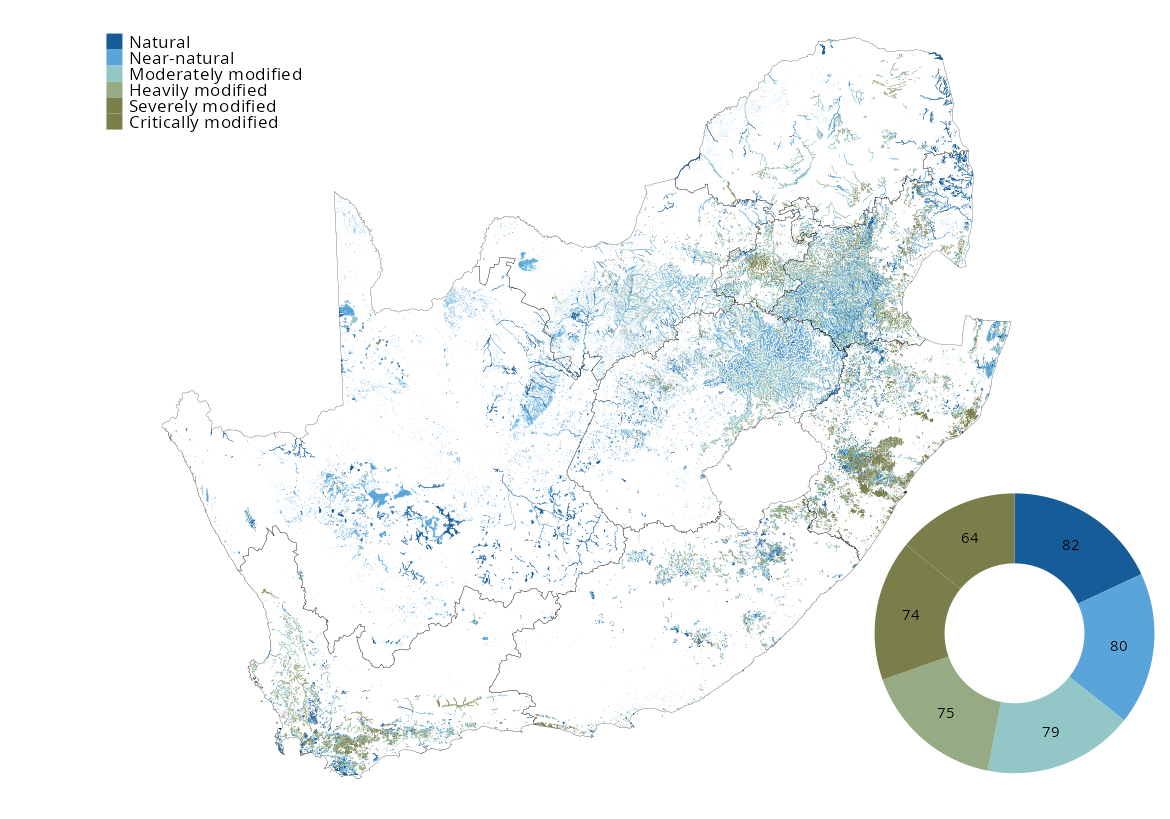
While numerous policies and strategies aim to improve or at least stabilise the ecological condition of wetlands in South Africa, overall wetland condition continues to deteriorate. Continued wetland loss and declining ecological condition has led to significant ecological and financial loss. This deterioration is often gradual and ‘out of sight’ and, therefore, generally not perceived as an immediate threat. It is, however, a serious concern which should be addressed through restoration (where feasible and strategic) and improved, frequent, monitoring and reporting.
of 82 inland wetland types
Natural or Near-natural
of wetland extent
Natural or Near-natural

Ecological condition was calculated for 171 303 wetlands. Of these, approximately 1 476 561 ha (49%) of inland wetland extent and # (58%) of inland wetland ecosystem types have been assessed to be in natural (class A) or near-natural (class B) ecological condition. Approximately 808 325 ha (27%) of inland wetland extent and # (x%) of inland wetland ecosystem types have been assessed to be in a moderately modified (class C) ecological condition and approximately 705 797 (27%) of inland wetland extent and x% of inland wetland ecosystem types have been assessed to be in severely modified (class D, E or F) ecological condition.
Of the different hydrogeomorphological types, depression wetlands are in the best ecological condition, with 14% of depression wetlands Severely Modified, 11% Moderately Modified and 76% in a Near-Natural or Natural ecological state. Floodplain, unchannelled valley-bottom, and seep wetlands all appear to have 42% Severely Modified wetland extent, with 34%, 35%, and 42% respectively in Near-Natural or Natural ecological condition. xxxxx [Need to re-run numbers]

| Natural | Near-natural | Moderately modified | Heavily modified | Severely modified | Critically modified | ||
|---|---|---|---|---|---|---|---|
| Depression | Count | 22 | 22 | 21 | 21 | 20 | 19 |
| Extent (km2) | 4 558 212 | 68 093 122 | 8 704 846 | 4 572 858 | 2 120 896 | 4 263 932 | |
| Seep | Count | 21 | 19 | 20 | 18 | 18 | 17 |
| Extent (km2) | 14 149 244 | 5 768 413 | 8 965 628 | 6 488 640 | 10 237 060 | 2 761 869 | |
| Unchannelled valley-bottom | Count | 20 | 20 | 19 | 18 | 18 | 13 |
| Extent (km2) | 527 898 | 487 471 | 678 629 | 357 543 | 337 313 | 73 198 | |
| Floodplain | Count | 19 | 19 | 19 | 18 | 18 | 15 |
| Extent (km2) | 7 460 119 | 10 368 373 | 15 539 633 | 7 976 889 | 7 609 380 | 924 305 | |
Download the data here.
Wetlands are complex systems that are influenced by multiple biotic and abiotic factors. Determining wetland ecological condition requires a multidisciplinary approach that allows for determining a single condition score from all the xxx/ While previous approaches to determine wetland condition at the national scale were sound, they lacked the wholistic and xxx approach of MacFarlane et al. (2020). The structured nature of this approach allows for a collaborative xxxx present ecological state (PES) scores, also allows for the inclusion of infield expert validated data that collect xxx approach for national wetland map assessment.
Approach to develop this input layer
Wetland ecological condition was determined using an automated approach (ArcGIS python scripts) of the Level 1A method described xxx MacFarlane et al. (2020), which is a low confidence, non-detailed approach that is suitable for assessing multiple wetlands xxx those of a national wetland inventory. In addition to being typed according to Ollis et al. 2013, the method also requires xxx wetland to have a 200 m buffer, as well as have its area of influence mapped. While the 200 m buffer is created by the automated process, the area of influence was created using a separate, but also automated, process. This allows the area of influence to be the actual wetland catchment, instead of buffers as were used during the previous NBA assessment (Van Deventer et al. 2019).
Overall wetland condition was calculated from the combined state of wetland hydrology, water quality, geomorphology, and vegetation, which were all calculated from the inferred pressures of different land cover classes (MacFarlane et al. 2020).
The systematic nature of the PES process allows for the development of a base dataset which can be augmented by expert data. xxx has been initiated through selected expert engagements with the National Wetland Map team, during which spatial extent, typing, and PES data were xxx for individual wetlands and wetland complexes. While the expert scores [were not adopted], they represent the first step xxx building a reference dataset that will directly and indirectly inform future wetland ecological condition assessments.
In addition to allowing for the rapid assessment of multiple wetlands, the automation of a standardised PES method xxx the opportunity for temporal analysis by applying land cover grids from different time periods as input data. This may potentially xxxx series analysis that will reveal not only the trajectory of change in wetland ecological condition over time, but also what is responsible for xxx.
Technical documentation
Code repository:
Publications
Technical reports
Recommended citation
Collins, N.B., Job, N.M., Awuah, A., Currie, J., other names xx. 2025. Inland wetland ecological condition assessment: Freshwater (inland aquatic) realm. National Biodiversity Assessment 2025. South African National Biodiversity Institute. http://nba.sanbi.org.za